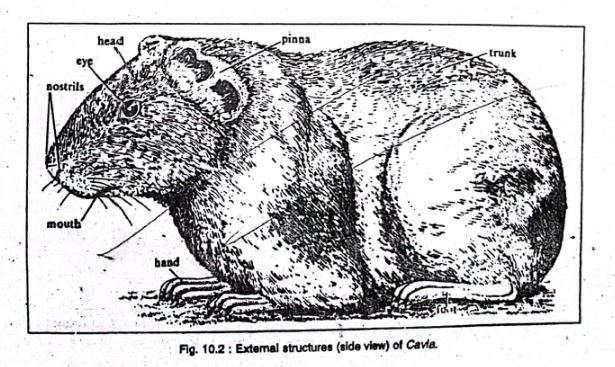In this article on Cavia porcellus or Guinea Pig, we are going to learn about 1. The systematic position, 2. Habit & habitat, 3, External Morphology of Cavia porcellus.
Cavia porcellus is the scientific name for a Guinea pig. The name Guinea pig is misnamed. Neither they are from the island of Guinea, nor they are closely related to the pigs biologically. They are from Rodentia order. The origin of the name is still unclear. They are much in demand as useful laboratory animals.
Systematic Position of Cavia porcellus
Kingdom: Animalia
Phylum: Chordata
Sub phylum: Vertebrata
Class: Mammalia
Order: Rodentia
Family: Caviidae
Genus: Cavia
Species: Cavia porcellus
Habit and Habitat of Guinea Pig
1. Wild Guinea pigs are cosmopolitan.
2. They are domesticated animals.
3. They avoid both bright sunlight and darkness. That’s why they are crepuscular.
4. They generally prefer marshy land to live in.
5. They feed on fruits and green vegetation.
6. Cavia has the habit of passing their food twice through their alimentary canal.
7. The faecal matter they passed during the daytime is dry and hard but the faecal matter they passed during the night is soft with much mucus.
8. They again take the soft faecal matter they passed at night and that’s why are called coprophagous.
9. They are terrestrial anima and cannot climb.
10. They are burrowing animals but they are poor burrowers. That’s why they take shelter in the natural burrowes or burrowes dug by other animals.
11. They maintain a territory where a dominant male, some females and young Cavia live.
Diagram of Cavia

Fig: External morphology of Cavia porcellus
External Morphology of Cavia porcellus
Shape, color, and size
1. Cavia can be 8 inches long from their mouth to the vent.
2. The body is covered with various soft hairs.
3. Some of the body areas are not covered with hair.
4. The body is divided into head, neck, and trunk.
5. The tail is absent but the tail bone is present at the posterior end of the body.
Head
1. It is short and triangular in shape.
2. Snout, external nostrils, mouth, eye, and pinna are present on the head.
A. Snout
1. At the anterior end of the head, the snout is present.
2. It is pointed anteriorly.
3. The snout lacks hairs.
B. External nostrils
1. External nostrils are present at the tip of the snout.
2. One pair of external nostrils present.
3. Several stiff and sensitive whiskers are present around the nostrils and they are called vibrissae.
4. The vibrissae work as a special tactile organ.
5. They help in respiration.
C. Mouth
1. Mouth is located beneath the nostrils.
2. It is bounded by upper and lower lips.
3. The upper lip has a cleft in the middle.
4. The upper incisors protrude with the cleft.
D. Eye
1. Eyes are round and large.
2. A pair of eye present and each are present on the lateral side of the head.
3. Each eye has three eyelids and they are the upper eyelid, lower eyelid, and third eyelid.
4. Upper and lower eyelids are movable.
5. Third eyelid or nictitating membrane is whitish, transparent, and vestigial.
E. Pinna
1. A pair of pinna is present on each posterior-lateral side of the head.
2. They are elongated, flap-like, movable folds of skin.
3. They are cartilaginous.
4. It stands erect in young but droops forward in older ones.
5. They work as the external ear.
Neck
- Cavia can independently move its head with the help of its neck.
- The neck is short and flexible.
- It is a bridge between the head and trunk.
- It merges imperceptibly with the trunk.
Trunk
1. After the neck, the whole posterior part of the body is the trunk.
2. It is cylindrical in shape.
3. The trunk is divisible into two parts, the thorax and the abdomen.
4. The thorax is supported by ribs and sternum.
5. The abdomen has no bony support.
6. The trunk bears paired mammary glands which open to the external through nipples.
7. Nipples are poorly developed in males.
8. At the posterior end of the trunk there is an aperture named the anus.
9. The urinary and genital apertures are located beneath the anus.
10. In males, both urinary and genital openings are present at the tip of a muscular organ called the penis.
11. In females, urinary and genital openings are separate.
Limbs
1. Limbs are present on the trunk.
2. Two pairs of limbs are present and they are the forelimbs and hindlimbs.
3. Each forelimb consists of an arm, forearm, wrist, and hand. And each hindlimb consists of a thigh, shank, ankle, and foot.
4. Each forelimb has four digits.
5. Each hindlimb has three digits.
6. Claws are present at the end of the digits.
7. The claws of the forelimbs are short.
8. The claws of the hindlimbs are long, slightly curved, and extended.
9. Forelimbs are used in burrowing.
10. Hindlimbs are used in leaping during locomotion.
———— THE END ————–
Read More:
- Nervous System of Guinea Pig | Cavia porcellus | Diagram
- Circulatory System of Guinea pig | Cavia porcellus | Diagram
- Respiratory System of Guinea Pig | Cavia porcellus | Diagram
- Digestive System of Guinea Pig | Cavia porcellus | Diagram
- General Characters of All Classes of Vertebrates.
Reference:

Md Ekarm Hossain Bhuiyan is a dedicated zoology graduate with a profound passion for the study of animal life. He completed his primary and secondary education at Ispahani Public School and College, renowned for its commitment to academic excellence. He then pursued his secondary education at Government Science College. After that he achieved graduation at Department of Zoology, Jagannath University. His educational background and enthusiasm for zoology position him to make meaningful contributions to the field of biological sciences in Bangladesh.